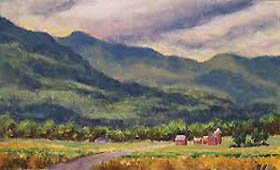
Not so fast. Beginning in 1980, the Marin Agricultural Land Trust (MALT) tried that strategy for a few decades amid coastal pastures just north of San Francisco, and it worked for a while. But then a new predicament popped up. City dwellers were cashing out of the urban real estate market in exchange for rural estates. Instead of the specter of suburban sprawl, trophy homes with hundred-acre backyards were threatening to supplant the area’s historic ranches. Although the new owners might leave the open space untouched, they might also withdraw the parcel from the local farm base.
Students of economics might wonder why productive land would fall out of cultivation. If the farm was economically viable, wouldn’t the owner either cultivate it or lease it to someone else who would? The answer lies in consumer preferences: affluent owners, for example, might value their privacy more than the extra revenue they could expect from a lease for someone to farm on their land.
“You have this situation on both coasts,” says Jim Oldham, executive director of Equity Trust, a Massachusettsbased land trust that operates nationwide. “You have it wherever you’re close enough to a city that money can get to the countryside easily.”
To keep land in farming, not merely in open space, Oldham’s group has made use of several methods. It may acquire an option to purchase the property at its agricultural value. Then, if the land is about to be sold for a nonfarm use, the trust can buy it and turn it over to a farmer at an affordable price, subject to a similar restriction. Another method is to include an “affirmative” farming clause in the easement, which requires the land to stay in production. Finally, the land trust can hold title to the property and lease the ground to a farmer, who would own the improvements but not the underlying land.
On Live Power Farm in northern California, the Decater family was farming organically on ground they had leased from a private party. When the land went up for sale, they couldn’t afford to buy it at full market value on the strength of their farm income alone. But after Equity Trust bought a conservation easement that guarantees the farm will be cultivated and allows the trust to buy it at its farm value if it were ever to fall out of production, the Decaters were able to afford the remainder of the purchase price. Many of the subscribers to the Decaters’ Community-Supported Agriculture arrangement, who receive a weekly share of the produce grown on the farm, made donations to Equity Trust to help fund the easement’s purchase—providing secure land tenure to the farmers who raise their food.
In New York’s Hudson Valley, Equity Trust helped a pair of established farmers find a permanent site for their operation. With donations, the trust bought the 150-acre site and committed the land to the farmers in a 99-year lease that requires the land to remain in cultivation. The farmers bought the house and other improvements but were buffered from the escalating price of land. Equity Trust has carried out similar projects in Massachusetts and New Hampshire, and recently several other land trusts have adopted analogous strategies.
Back on the West Coast, MALT now negotiates for easements that require the property to stay in agricultural production. If the owner doesn’t ranch it or lease it for grazing, the land trust can step in and broker a lease itself.
As MALT executive director Bob Berner points out, farmland preservation is different from other kinds of conservation. “Most other easements are preserving a natural feature of the property,” he says. “These are protecting a particular human use.”
Look a little deeper, though, and a similarity emerges. The underlying purpose of many easements is to protect habitat for a threatened species, such as an eagle. These agricultural easements aim to protect habitat for farmers—if the land is whole but unfarmed, the soil may be intact, but the creatures whose habitat was to be protected (the farmers) will be as bereft as if it were covered in asphalt.
Submit your Impressions of markets and the environment to: Laura@perc.org


